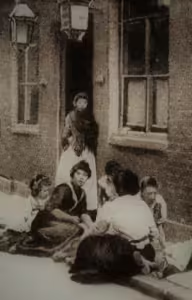
The killer still unknown more famously known as Jack the Ripper murdered women in the Whitechapel district of London, England in 1888. The murderer also came to be known by the name of the Whitechapel Murderer, and Leather Apron in the police documents and newspaper articles. These cases are among the most violent that can be classified under the genocide crimes and to date the identity of the murderer is unknown.
The victims therefore included mostly women who were offering their services as prostitutes in the slum area of the East End. The actions done by the killer included the cutting of the neck of the victims this was after sexually assaulting them and going further to remove the vital organs found in the abdomen. This prompted people into thinking that the killer could have been a physician or someone with an excellent knowledge of human anatomy. Frenzy arised in the area as the brutality of the killer increased with the latter sending letter to the press, some of which were purported to come from the murderer. Jack the Ripper got his nick name from this letter known as the “Dear Boss” letter even though this letter is thought to have been a forgery to get people interested. Another very famous letter is the “From Hell” letter, written and sent a local vigilance committee with half of kidney of one of the victims.
Eyerly’s murders were influential to media which reported a lot on the murders hence ensuring that the story would not die out. Over the period of 1888-1891 police had been involved in probing eleven murders; however the “canonical five” believed to have been done by Ripper are Mary Ann Nichols, Annie Chapman, Elizabeth Stride, Catherine Eddowes, and Mary Jane Kelly. These murders took place between August and November in the year 1888 and despite the many attempts made to solve the case, it has never been solved.
Stoke Newington was a relatively well-off part of London in the mid-nineteenth century and had only a few inhabitants of working-class Irish and Jewish immigrants who began to move there in waves. This time saw the society experience social conflicts, increase in crime rates, violence and poverty. By 1888 the Whitechapel district housed around 1200 prostitutes and at least 233 common lodging houses in which many of the victims resided. These murders further contributed to worries in an already unrestful area which eventually helped to solidify the locale’s unfortunate moniker of Whitechapel.
Although as it has been already mentioned with regards to the person who is infamously known as the murderer known as Jack the Ripper no one was ever made known or arrested for the evil deeds that he did in his wicked course. Thus, the case has remained open to this date, a story that is partly true, partly a legend and a lot of guess work that still captures the public’s imagination.
Later Whitechapel Murders
It is believed Mary Jane Kelly was the last of all victims that fell to the deft knife of Jack the Ripper. This means that the murderer could have died, have been imprisoned, institutionalized, or emigrated and therefore the killings ceased. However, the Whitechapel murders file also includes four other killings that occurred after the canonical five: These include Rose Mylett, Alice McKenzie, the Pinchin Street torso and Frances Coles.
Thus, on 20 December, 1888, the lifeless body of a 26-year-old woman Rose Mylett was discovered in Clarke’s Yard, in Poplar. There were no signs of a scuffle and no abrasions on her skin, but from the marks on her neck one could easily tell she had been strangled. At first the police believed that she had committed suicide while drunken or hanged herself in her sleep while the inquest showed that it was a case of murder.
Richard Spencer became the second Ripper victim assaulted and killed in Castle Alley, Whitechapel on the 17, July 1889. She had two injuries in to her neck and one of the injuries cut the carotid artery. There were some rumoured experts who thought it to be the handiwork of the Ripper while there were some who disagreed with such an opinion. To this day there is confusion surrounding the murder of McKenzie as some claimed it was carried out by a killer who was imitating that of the Ripper.
‘The Pinchin street torso’ was found on September, 10 1889 in the subway under the railway arch in White Chapel. The head and several limbs had been severed, but she had also been beaten mercilessly and there were marks of cuts on most parts of her body but not of a romantic kind. It was said that her bones were buried in the said place and wrapped in additional garments.
Frances Coles was discovered under a railway bridge in Whitechapel on the thirteenth of February, 1891, with her throat cut and no further dismemberment. This made people think that the murderer of her had probably been interupted. The man, named James Thomas Sadler, was arrested for her murder; he was also considered an antagonist of the Ripper and was released because of lack of evidence.
Other Alleged Victims
This, however, has been speculated and there are other crimes through out the Whitechapel other than the eleven that have been attributed to Ripper. The case of ‘Fairy Fay’ is one of such case although majority of people think it is a fabricated case out of the attack on Emma Elizabeth Smith. In the same manner, some women who were attacked by the Ripper that lived through them include Annie Millwood and Ada Wilson that was attacked in 1888 but has been associated to the Ripper albeit with little proof.
 Another incident that had a connection withripper was the discovery of mutilated torso of a woman in October of 1888 referred to as the Whitehall mystery. It was suggested that this case was linked to the ‘Thames Mysteries’ a string of murder associated to yet another serial killer known as the ‘Torso killer’ despite his modus operandi differing from Ripper.
Another incident that had a connection withripper was the discovery of mutilated torso of a woman in October of 1888 referred to as the Whitehall mystery. It was suggested that this case was linked to the ‘Thames Mysteries’ a string of murder associated to yet another serial killer known as the ‘Torso killer’ despite his modus operandi differing from Ripper.
Another high profile case was John Gills aged seven years, who was murdered in Bradford in December the same year 1888. He had been sexually assaulted in the same manner as all the Ripper’s victims and this raised suspicions that he might be involved but this was never proven.
Investigation
Most of the papers of the City of London Police related to the Whitechapel murders were lost during the Second World War bombings but some papers and files of the Metropolitan Police help if shedding light on the murder investigation. A huge police operation was conducted, searches, and investigations were conducted from house to house, finger marks, more than 2000 interviews were taken. However, the killer was not found yet.
In most of the investigation, Detective Inspector Frederick Abberline was in charge of the operation together with the City of London Police after the murder of Catherine Eddowes. Challenges were encountered during the investigation among them included the fact that Assistant Commissioner Robert Anderson was on leave during some of the key murders. It was only after several weeks that a chief inspector Donald Swanson was sent to take overall charge of the investigation from the Scotland Yard.
Considering the fact that the kind of mutilations that were done, butchers, slaughterers, surgeons and physicians were thought to have been involved in the incident. All local butchers were questioned but they too were disposed off. Some thought that the murderer could be a cattle drover from one of the boats which arrived at the Whitechapel regularly but this idea could not be realized. There exists no doubt that numerous attempts have been made to deal with the case but the identity of the infamous Jack the Ripper still remains unknown.
Whitechapel vigilance committee:
In September of 1888 east end of Londoners organized vigilance committee of White chapel which roamed the streets in search of suspicious persons. They were unsatisfied with police inabilities to arrest the killer and other more issues regarding the impacts of those murders to businesspeople having their businesses closed. It also informed the government to do so and even the committee had declared wanted – £50 of information that may lead to the murder of the suspect. Also, they sought for private detectives.
Criminal Profiling Based on the compassion and concern of the police, Anderson consulted with Dr. Thomas Bond towards end of October, 1888 to determine whether the killer might be an expert surgeon or not. These consultations led to what can be regarded as one of the first ever criminal prof¬iles ever created. In vanishing this case for the consideration of any expert in pathology, Bond became satisfied, after inspecting the most mutilated victim and glancing at postmortem notes of four previous and more generally canonical murder committed in Birmingham pertaining to the same(pointer 2), this man was indeed the same person who killed both the girls. He said that in four of the cases the throat was cut from left to right though in the fifth case the body had been so mangled that the direction of the cut could not be identified. According to Bond all the victims were lying down on the ground when attacked and the throats were first slashed.
As some thinking went, Bond likewise vigorously denied that the murderer had any medical or anatomical learning, whatsoever. The man he said that probably was a solitary man who suffers from ‘periodic attacks of homicidal and erotic mania’ He related it to a disease called satyriasis. He also suggested that the reason for the behaviour of the killer could be due to harboring some anger and intent of revenge Even so, he ruled out the aspect of religious mania as a factor in the case.
Independent of this, some psychologists have opined that since there was no rape of the victims, but the killers ambushed and mutilated the bodies in sexually suggestive positions, then the murderer got some form of sexual satisfaction out of it. However, there are theories by other researchers who have disagreed with such interpretations going as far as describing them as conjectural.
The case is made not easier to investigate given that their exists no forensic proof in the case. The letters that were sent for DNA testing are the only ones that remained and hence when the samples were taken for testing, the material was highly contaminated that it was impossible to glean any conclusive tests from it. There have been numerous theories that have been made in the past that DNA was found to be linked to some suspects like Aaron Kosminski a barber at the Whitechapel area or artist Walter Sickert, the method has however had people criticizing the science behind it.
Suspicion Many people have tried to make a guess as to who was the actual Jack the Ripper, with there being a lot theories. It has been argued that Ripper was a regular working man from the Whitechapel area because most of the brutal killings took place during the weekends or holidays, on the other hand some have suggested that Ripper could have been a well-educated, socially respectable well-to-do man probably a doctor or a gentleman from some upper class area in London going for his disgusting past time sprees at Whitechapel during the weekends or holidays. These ideas relate to the general culture people hold, for instance, there is distrust in doctors and other medical practitioners and the advantages that the rich get over the poor. The mystery that surrounds the discovery of Jack The Ripper has even created some field of study known as ‘Ripperology’ and it has been the subject of many fiction books.
It has since expanded though to more than a hundred and who has not been looked at by Scot Yard, it has increasingly become a lengthy list. These are some of the famous personalities, which includes Prince Albert Victor, artist Walter Sickert and author Lewis Carroll. However, due to comprehensive analysis of the case it still remained unsolved and most of the conclusions are rather conjectural about the identity of Ripper.
Letters
During the investigation several police, newspapers and other individuals received hundreds of letters purporting to shed light on the case. Most of these were hoaxes, though three stand out: these as the “Dear Boss” letter, the “Saucy Jacky” postcard, and the “From Hell” letter.
The “Dear Boss” letter, written on 25 September and posted on the 27 September 1888 was first considered as an imitation. However, the letter which claimed that some parts of her body particularly her ear would be sent had some truth in it when Eddowes’ body was found and one of her ears was missing. This letter was the first to use the name “Jack the Ripper” which was to become famous in the future.
The “Saucy Jacky” postcard changed into obtained on 1 October 1888, quickly after the double murders on 30 September. The postcard’s connection with a “double occasion” led some to trust it have been sent by way of the killer before the information of the murders have become public. However, it become postmarked extra than 24 hours after the killings, whilst details have been already widely recognized.
The most infamous conversation, the “From Hell” letter, become despatched to George Lusk, the head of the Whitechapel Vigilance Committee, on sixteen October 1888. It came with 1/2 of a human kidney, claimed to be from one of the sufferers. While the letter became chilling, experts have disagreed on whether the kidney honestly belonged to the sufferer, Catherine Eddowes, or whether or not it was a part of a grotesque hoax.
Media
The Ripper murders marked a turning point in the dating among crime and the media. Jack the Ripper have become one of the first serial killers to generate good sized worldwide media coverage, with newspapers seizing on the case to power readership. In 1888, extra of the operating-class population in England and Wales became literate, and tax reforms had led to the rise of cheaper, mass-stream newspapers. Sensational reports, frequently packed with speculation and incorrect information, have become not unusual. The press even performed a role in spreading xenophobic rumors, together with claims that the killer become Jewish or overseas.
The media’s extreme cognizance at the case and the eventual adoption of the nickname “Jack the Ripper” helped cement the murderer’s legacy. This set a precedent for how serial killers would be portrayed in the press, and lots of future killers would accept comparable monikers, drawing at the mystique created by way of the Ripper legend

